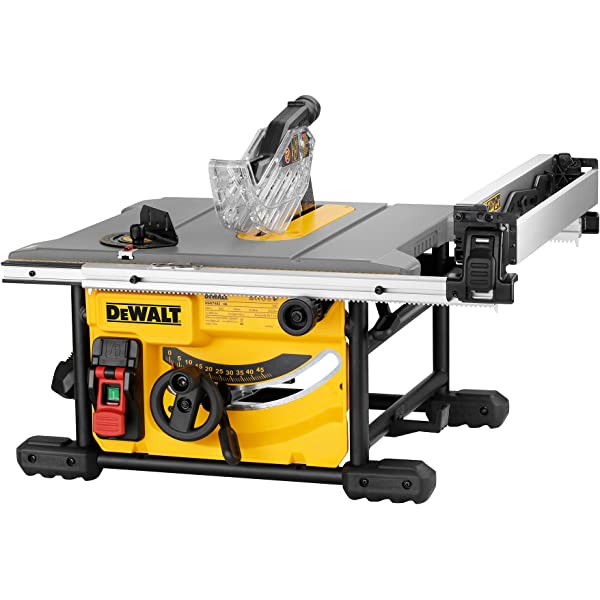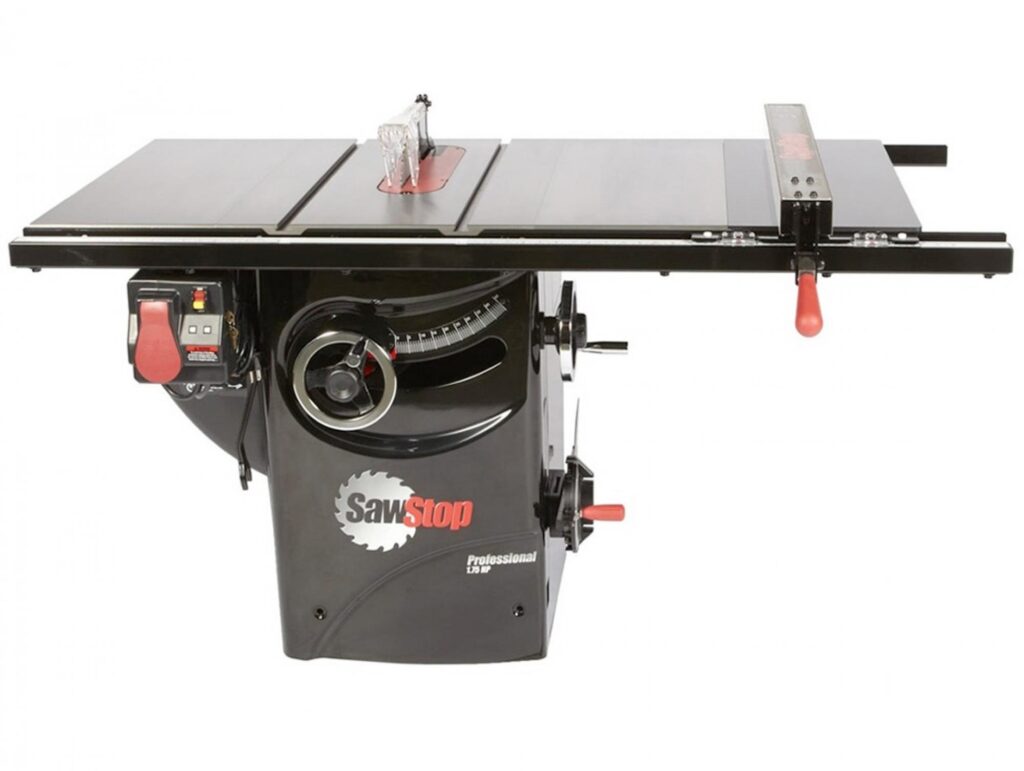Do you want to know whether you should buy a cabinet saw or a table saw next?
One kind of table saw is the cabinet table saw. Table saws come in all sorts of shapes and sizes, from small ones that can be carried around to big ones that stay in one place in a workshop. People who don’t know the difference generally mean a “contractor table saw” when they say “table saw.”
The main difference between a cabinet table saw and a contractor table saw is that the cabinet table saw is better made and costs more. They both do the same thing, but a cabinet saw is a very well-made machine made for professionals and the most experienced amateurs.
Check out the comparison between a cabinet saw vs table saw.
What is a Table Saw?

A table saw is a very special type of woodworking tool that is often used in shops and on job sites. The main thing that makes a table saw a table saw is that it has a big table with an infeed and an outfeed.
This is made to hold the wood while it goes over the blade. The blade of a table saw is attached to the flat table and sticks up through it. Most of the time, this blade can be changed in height and angle. Then, table saws usually come with fences and miter gauges as well.
Most table saws are pretty big and are made to cut big pieces of wood. Most of the time, table saws are only used for cutting wood. They aren’t really made to cut anything else. Now, it’s important to remember that there are different kinds of table saws, which is where the confusion comes from.
Yes, a cabinet saw is a type of table saw, if you hadn’t already guessed. The contractor saw is the other type of table saw you should know about. In this piece, we will compare contractor saws and cabinet saws, both of which are types of table saws.
A contractor table saw is a type of table saw that is made to be small and easy to move. These are made to be moved from one job spot to another by contractors. They work just fine, but they aren’t very big.
What Is a Cabinet Saw?

The cabinet saw, which is the biggest type of table saw, comes next. The underside of this table saw, the motor, and everything else are all enclosed in a big, solid cabinet. This is what makes it stand out.
This has a number of advantages, such as better protection for the motor, better dust collection, a more stable and solid base, and a bigger working area. Let’s move on and look at what cabinet saws and contractor saws have in common.
Eight Differences Between Table and Cabinet Saws:

In woodworking, table saws and cabinet saws are two of the most commonly available sawing instruments. They are distinct in terms of motor size, tabletop size, cutting capacity, weight, and precision.
The table saw has a smaller motor, typically around 1.75 horsepower, and a more compact benchtop than the cabinet saw.
Three to five horsepower is produced by the motor of a cabinet saw, and larger tables provide greater cutting capacity and precision.
Due to their superior power, table saws are better adapted for detailed work, such as cutting small pieces or creating intricate patterns, whereas cabinet saws are ideal for large projects.
Frequently, cabinet saws include dust collection systems that make it easy to manage your workstation during a project. We will delve deeper into the distinctions between table saws and cabinet saws, investigating the various characteristics of each tool.
The Difference Between Table Saws and Cabinet Saws: Cabinet Saw vs Table Saw
One kind of table saw is the cabinet saw. There are many different kinds of table saws, such as compact, benchtop, Jobsite, contractor, hybrid, cabinet, and folding table saws.
Jobsite saws, contractor saws, and cabinet saws are the three main types of table saws. Let’s look at how table saws and cabinet saws are different.
1)Size of the Motor and Power Output:
Cabinet saws have bigger, more powerful blades than table saws. Most job site and contractor table saws have motors that are 1.75 hp, while cabinet table saws can have motors that are up to 3-5 hp. This gives cabinet table saws the ability to make more powerful cuts.
Cabinet saws can cut bigger pieces of wood more easily and accurately because they have more power. This makes them a great choice for professional woodworking jobs.
2)Table Size:
The size of the table is another big difference between table saws and cabinet saws. Jobsite table saws are made to be easy to move around, so the tables are small. It’s easy to move from job site to job site.
The tables on contractor table saws are a little bit bigger than those on Jobsite models, but they are still smaller than those on cabinet saws.
Most cabinets saw tables are at least 7 feet long and have a lot of space for big pieces of wood or complicated routing jobs. They also come with fences that can be moved, which makes it easy to cut long boards accurately.
3)Motor Placement:
The location of the motor on the rest of the saw’s frame is another big difference between these two types.
In both Jobsite and contractor saws, the motor usually sits in an open base just below the top of the table. In a cabinet-style saw, the motor is placed inside a fully enclosed housing that sits much lower on the frame than either type of table-style model.
This difference makes most cabinet models much heavier and less portable than their smaller peers. This is because their low center-of-gravity design makes them more stable when in use.
4)Band saw with High Cutting Capacity and Accuracy:
Because of how they are made, table saws generally have less cutting capacity than cabinet saws. Most table saws have a flat work area that limits the size and thickness of boards they can cut.
On the other hand, cabinet saws have a higher platform that makes it easy to cut bigger pieces and thicker boards.
Because they can cut more, cabinet saws are also better for making cuts that need to be very exact, like those needed for making furniture or fine cabinetry. Table saws are also less exact than cabinet saws when it comes to making cuts.
5) Dust Collection Capabilities:
Dust gathering is another big difference between table saws and cabinet saws. Table saws are not generally equipped with any dust collection system as standard, although some models may offer this feature as an option.
Even if they are available, dust collection systems for table saws rarely work well because the motor is usually under the working area. This will make it hard for air to move during operation.
Cabinet saws feature a raised platform design which allows for a better link with a vacuum cleaner. It will make it easier to get rid of small particles from the job area.
Due to this, they are well suited for work that involves large amounts of woodworking shavings and scraps, such as the construction of furniture and cabinetry.
6) Weight:
The weight of a table saw can vary greatly depending on the type. Jobsite and contractor table saws are typically less weighted than cabinet saws, with the average contractor table saw weighing around 600 pounds.
Cabinet saws, on the other hand, are much heavy and can weigh up to 700 pounds when fully put together. This is because they are bigger and made out of stronger materials so they can hold bigger workpieces.
7) Need for Space:
Table saws generally do not require a significant amount of space. Cabinet saws, on the other hand, need a lot more space to work properly.
This is because cabinet saws typically have wider wings that extend out from the main body of the machine. This will increase the area available for adding accessories, such as miter gauges and fences.
Cabinet saws tend to stand higher off the ground than other types of table saws, which makes their overall size bigger.
8) Vibration Dampening:
When turned on, table saws are known to make a lot of vibrations, which can make them hard to work with at times.
Cabinet saws are better at reducing vibrations because they are bigger and heavier, which gives them more steadiness while they are in use.
Many high-end cabinet models have rubberized feet or special motors that help dampen vibrations even more. This makes it easier for users to make precise cuts with less effort.
How Long Do Table and Cabinet Saws Typically Last?

How long a table saw or cabinet table saw will last depends on many things, such as how well they are cared for and maintained.
In general, a saw should last for a long time if it is used correctly and cared for regularly. How long exactly depends on the product and how it is used.
Because of how they are made, table saws tend to last for a long time. Most of the time, they have a top plate made of cast iron or steel that is linked to aluminum side frames or rails.
Because of how they are made, they are strong enough to use in tougher conditions than other saws. The motor moves the table saw blade, which is surrounded by a guard system to protect against accidental contact with spinning blades.
This type of saw is likely to last about 10 years if it is used right and cleaned and oiled on a frequent basis.
Cabinet saws can last even longer than table saws because they are usually made of heavier and more durable materials, like cast iron or steel, depending on the model.
They also have bigger batteries that don’t need to be fixed or serviced as often. This means that with proper care, they can last up to 15 years.
Cabinet saws also have guards that are stronger and safer than those on table saws. Also, the best cabinet table saw has different features, such as longer fences, stronger miter gauges, larger tables, and dust collection systems. Because of these things, they are much more useful than table saws.
To make your cabinet saw last as long as possible, you should lubricate it regularly according to the instructions in the owner’s manual. You should clean often to keep things from getting dirty over time.
If they are taken care of, both table saws and cabinet saws can be used for many years. Though cabinet saws tend to last longer than table saws because they are stronger and have more features.
Table Saw versus Cabinet Saw: Which Should You Purchase?
A table and a cabinet saw are both excellent tools for woodworking jobs, but the one that is best for you will depend on your needs and preferences.
Table saws are used to cut wood by both amateurs and pros. They have a round blade that is attached to an arbor. In this way, it is possible to cut material to different levels by raising or lowering it.
The main benefit of table saws is they don’t take up much space, and they are relatively inexpensive compared to other options on the market. But table saws don’t cut as precisely as cabinet saws, and their blades are usually not as strong as those in cabinet saws.
Cabinet saws are bigger than table saws and are made of stronger materials. This includes tables made of cast iron, motors with more power, and frames that keep dust and noise out.
Cabinet saws also have dado blades for cutting groove joints, the ability to rip wood, and accuracy for making accurate angle cuts. There are also more efficient dust collection devices available.
On the other hand, these models cost more than table models and take up more room in your shop or garage because they are so big.
In the end, you should choose between a table saw and a cabinet saw based on what your job needs. If you are working with big pieces of stock or need precise cuts for intricate joinery or delicate projects, a cabinet model may be the best choice.
On the other hand, a table model would likely be enough if you want something that costs less and takes up less space.
Both types of saw are good for woodworking jobs, so the choice comes down to what you want to do right now. Also, how much money do you plan to spend in the future on tools?
What Is the Safest Type of Saw Between a Table Saw and a Cabinet Saw?

Cabinet saws are without a question the safest table saw type. Most of the time, cabinet saws are bigger and stronger than table saws. But they also have different safety measures built in to make sure that the people who use them stay safe.
Full-enclosure guards and anti-kickback pawls on cabinet saws keep the user from getting hurt by the spinning blade.
Most of the time, these saws are quieter than other types of saws because their motors are driven by belts. The machine’s speed can be changed, so it can be used safely for delicate or precise jobs.
There is also a big table on the cabinet saw that provides a sufficient amount of stability and support when cutting materials. Many types have a dust port that pulls dust away from the work area. This makes it safer for the user.
Can a table Saw be Turned into a Cabinet saw?
Some table saws can be changed into cabinet saws, yes. To switch between the two types of saws, you usually have to switch out parts and add extras.
Some table saws, for example, come with a riving knife or splitter that can be used to line up the blade with the throat plate. This reduces kickback and makes the saw safer.
Cabinet saws often have bigger motors and longer arbors than table saws, which gives them more strength and makes them better at cutting. Most cabinets saw tables are deeper than a table saw tables, which lets you make cuts that are bigger.
To turn a table saw into a cabinet saw, the user usually has to change the motor and add things like dust collection systems, support rails, and extension tables.
To get the most out of all the features a cabinet saw has to offer, they may need to buy extra tools like wider miter slots and dado blade sets.
Bottom Line: Cabinet Saw vs Table Saw
By using all of the information in this guide, you can be sure you’re making the right choice about whether or not you need a cabinet saw or a table saw. We’ve gone over all of the important features and factors that you need to think about before deciding which saw is right for you.
You should always keep in mind the goals of your job and the materials you need to work with so you can buy the right saw for your needs. If you follow these steps, it won’t take you long to find the right table or cabinet saw for your shop or job site.
FAQs
Is it Safer to use a Contractor Saw than a Cabinet Saw?
Most of the time, a cabinet saw is safer than a carpenter saw because it has better safety features.
Even though they are more likely to be safer, this isn’t always the case, especially with cheaper models. On top of that, contractor saws often have the same safety features as more modern cabinet saws.
Can a track saw take the place of your circular and table saws?
Track saws are very precise and can easily replace a normal circular saw, but a table saw is still the most accurate and precise tool.
What is the Difference Between a Table Saw and a Cabinet Saw?
Here, the answer is pretty clear. A cabinet table saw is what you want if you need something big and fully useful that you can keep in your woodworking shop at all times. But the contractor table saw is what you need if you need a portable table saw that you can move from one job spot to another.
- How to Make Raised Panel Cabinet Doors on a Table Saw
- How to Reset Overload on Table Saw?
- What is a Riving Knife on a Table Saw?
- How to Make Shiplap Boards with a Table Saw
- Best Cabinet Table Saw: (Top Pick and Reviews)
- How to Cut a Taper on a Table Saw?
- How to Use a Circular Saw Without a Table
- How Thick is a Table Saw Blade
- How to Use a Table Saw For Beginners: (10 Easy Steps)
- How Many Amps Does a Table Saw Use?
- Can You Cut Plexiglass With a Table Saw?
- How To Sharpen Table Saw Blades
- How to Extend Rip Capacity of Table Saw?
- Can You Cut PVC With a Table Saw?
- Can You Cut Acrylic With A Table Saw?
